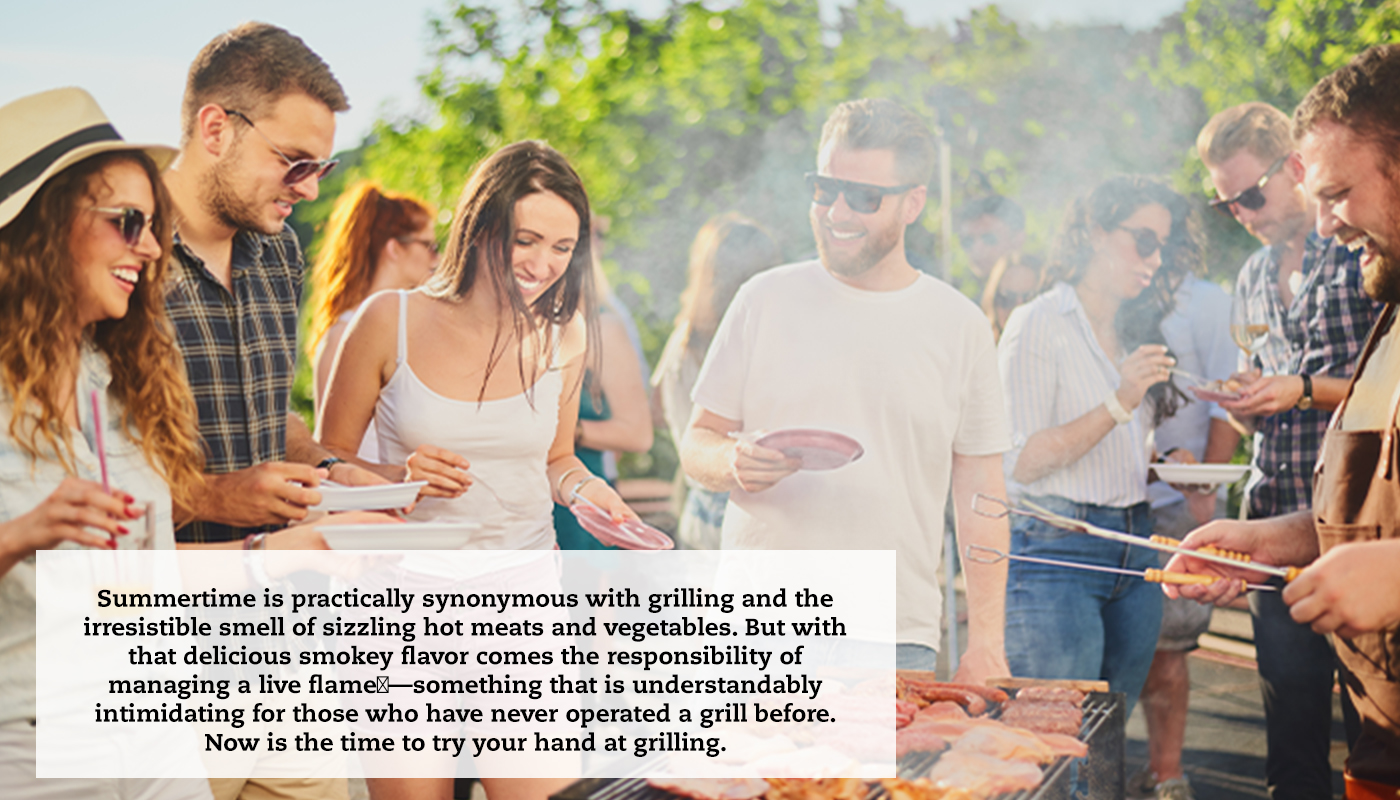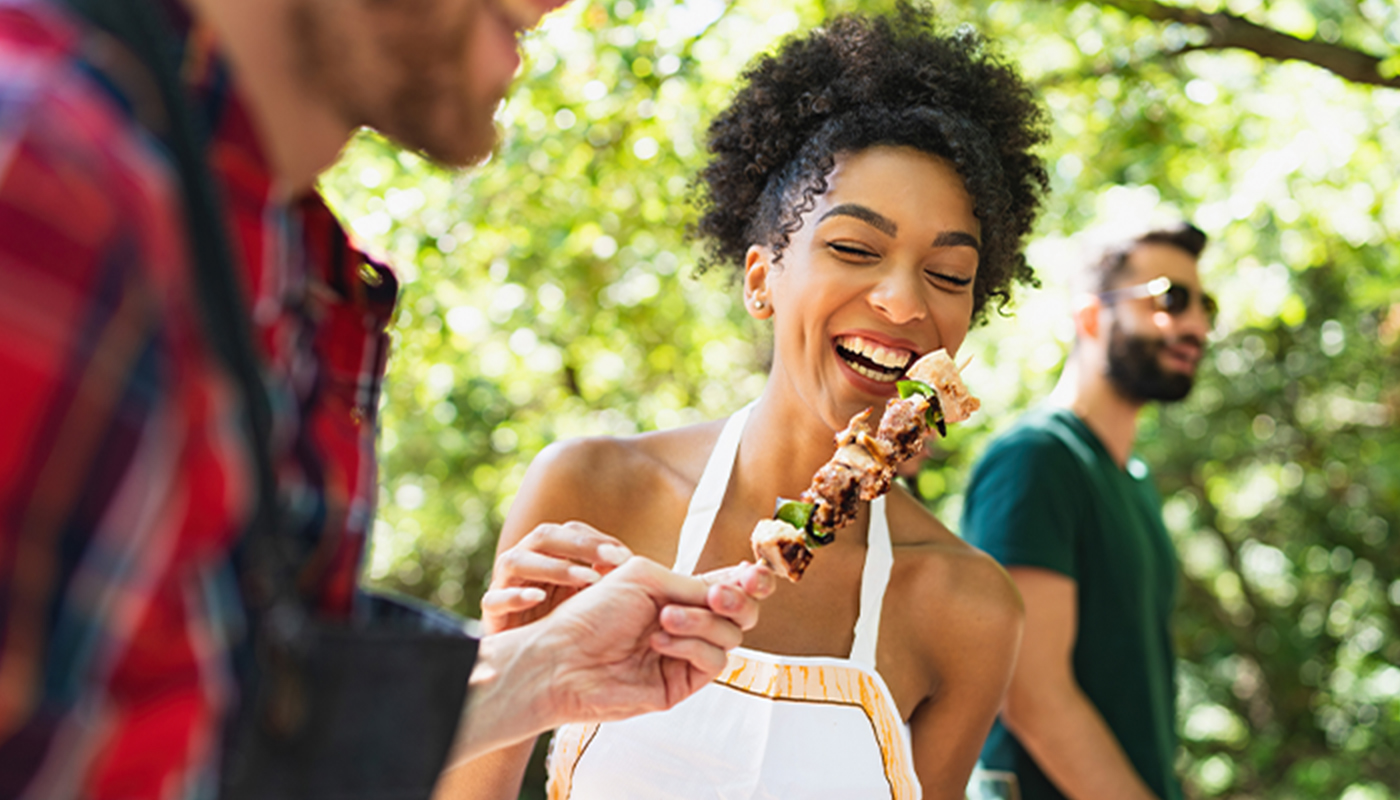Summertime is practically synonymous with grilling and the irresistible smell of sizzling hot meats and vegetables.
But with that delicious smokey flavor comes the responsibility of managing a live flame—something that is understandably intimidating for those who have never operated a grill before.
Now is the time to try your hand at grilling. Perhaps you’ve recently purchased a grill or moved into an apartment community where grills are offered as an amenity. Follow these beginner-friendly tips for how to safely and effectively cook food on the grill. Before you know it, you’ll be a grill master serving up a meal to be proud of!
Types of Grills
First off, match your grilling technique to the type of grill you’re using. With a traditional charcoal grill, there are no knobs, cords, or tanks. A propane grill draws its fuel from a tank under the cooking area. An electric grill has a cord you plug in. A gas grill taps into a home’s natural gas line. The type of grill will impact how you impart flavor to your entrees. Imparting smoky flavor varies from one type to another, for example.
Prepping the Grill
With charcoal grills, check that the bottom is free of debris. You don’t want to let residual charcoal or ash obstruct the heat source in any way. Clean grates are a must—preheat your grill to burn off any food and residue. Use a stiff-bristled steel brush on steel or iron grates to remove any remaining gunk or rust. Only use a nylon-bristled brush on coated, non-stick surfaces. Ceramic coatings are one example.
Finally, you’ll want a non-stick grilling surface. A light application of canola oil “seasons” the cooking surface.
Tips for a Great Grilling Experience
Here are some tips to make your outdoor cooking a success. You want your meal to be both tasty and safe. Follow these FDA recommendations for handling food safely.
Tools of the Trade
There are a few items you will need before you fire up the grill. Have your grill brush handy so that you can keep your grates clean. When cooking, be sure to use a spatula for burgers and fish and tongs for other meats. A heat-resistant cooking glove is another wise investment. Finally, always have a fire extinguisher nearby.
Know Your Temperatures
When the stakes are high, don’t trust your instincts alone. That prime rib or tomahawk steak is quite an investment. Nowadays, even hamburgers are! Therefore, make sure you’re working with an accurate meat thermometer. This beats cutting into the meat. You don’t want to release the juices that make a cooked steak moist and savory.
The traditional instant-read meat thermometer will set you back less than 10 bucks. Or, up your game with a digital, WiFi-enabled thermometer. For example, Weber’s IGrill3 delivers real-time results to your smartphone.
Controlling temperature is simple with electric, propane, and gas grills. Simply turn the temperature knob to the desired temperature. If you’re using a charcoal grill, open or close the vents to control the flow of air. More oxygen means more heat. You can also lower the cooking temperature by limiting the direct heat. Simply move the coals over to one side of the grill. Alternatively, you can use less charcoal to begin with.
Be Precise
Follow the “first on, first off” rule. That is, the first food to go on the grill should be the first food to come off of it. It is easier to keep track if you follow another rule: “careful spacing.” Even spacing equates to more even cooking.
Add Smoky Flavor
That smoky taste takes certain meats to another level. Soak and drain wood smoking chips before adding them to a standard charcoal grill. Do this as you begin to spread the food out on the grate. If you’re using a gas grill, add a foil pouch containing wood pellets. Punch holes in it to bathe your entree in smoke.
Time Your Sauces
Planning to coat ribs, pork, or chicken with barbecue sauce or glaze? Do so during the last 15 minutes or so of grilling, and turn frequently. The sugar in sauces and glazes will not hold up to high or prolonged heat.
Grilling Tips by Entree
The following time estimates are just that — estimates. Make liberal use of your meat thermometer to ensure excellent results. Keep in mind that cooking preferences vary from one grill master to another. To ensure thorough cooking, close the grill hood for a time when the meat is more than ¾” thick. Tastes vary as well, so poll your diners in advance!
Use high, direct heat for steaks. How do you like your steak grilled? Medium rare, medium, and medium well are popular responses. The internal temperature of a medium rare steak is roughly 125-135 degrees. For a medium steak, it is 135-145 degrees. For a medium well steak, it is 145-155 degrees. But be sure to avoid overcooking: remember that internal temperatures increase another 5-10 degrees once the steak comes off the grill.
High, direct heat is also ideal for fish wrapped in foil. For many a fish lover, grilled salmon is a true taste treat. A filet in foil requires about 10 minutes to cook.
Medium direct heat is often ideal for hamburgers and pork. For a cheeseburger, add a slice or two of cheese during the final minute. A thick-cut pork chop usually takes about 12 minutes to cook.
Medium, indirect heat is often preferred for both chicken and sausage. Using indirect heat, it will take about 20-25 minutes to cook chicken breasts. Chicken thighs grill particularly well due to their higher moisture content. The higher fat content of sausage points to indirect heat as well. Direct heat may cause excess charring or burning. One option is to cook your brats under indirect heat. Then switch to direct heat in the final minutes for some minor charring. Under indirect heat, the cooking time for brats is about 25 minutes.
Grilling Stations at Luxury Apartment Communities
If you’re a new Draper and Kramer resident in a community with a grilling station, you’ll want to take full advantage of this wonderful amenity.
Grilling stations are available at many Draper and Kramer properties. For example, grill out at Senita at Cave Creek, 25 minutes north of Phoenix. At the new Moda at The Hill in St. Louis, the courtyard oasis features grilling near the hot tub.
Urban settings need not be an obstacle to outdoor grilling. Burnham Pointe is in Chicago’s Printer’s Row neighborhood. Residents have access to grilling stations replete with premium outdoor appliances. Residents also enjoy the outdoor kitchen and dining area at the Grand Plaza in Chicago’s River North neighborhood.
About Draper and Kramer
Draper and Kramer is a full-service real estate firm founded in 1893. You’ll find our luxury apartment properties from Illinois to Missouri and from Arizona to Texas. Visit our website to browse our complete selection today.

If you’re a new Draper and Kramer resident in a community with a grilling station, you’ll want to take full advantage of this wonderful amenity. Grilling stations are available at many Draper and Kramer properties.